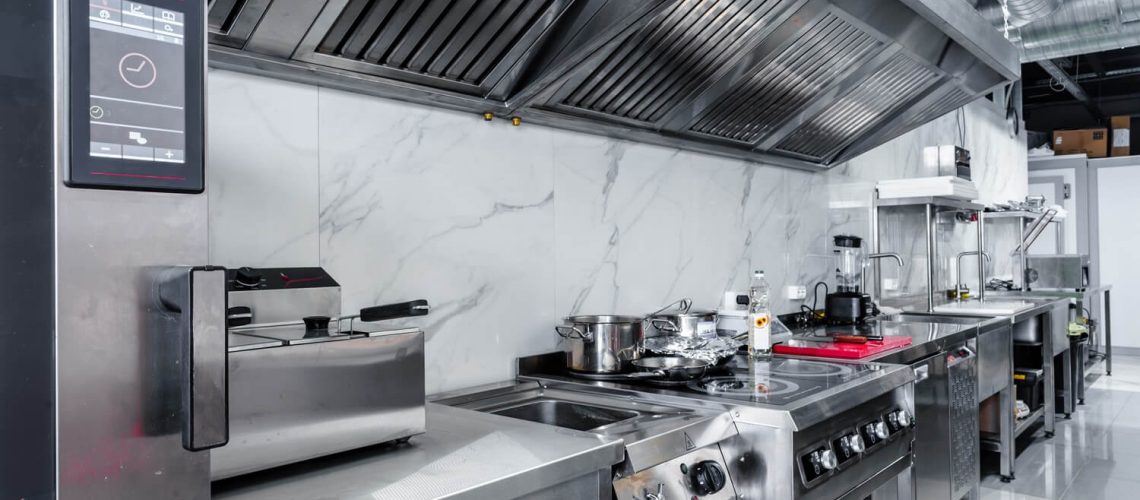Commercial kitchens are the heart of culinary operations, catering to the needs of the public with extensive cooking activities. To ensure the safety, comfort, and efficiency of these bustling environments, a reliable Commercial Kitchen Ventilation System is necessary.
In this guide, we will explore the key components, designs, benefits, regulations, and maintenance tips for an effective ventilation setup tailored to the demands of industrial kitchens.
Commercial Kitchen Extraction Regulations
Commercial Kitchen Extraction Regulations are legal obligations emphasizing workplace safety. According to the Workplace (Health, Safety and Welfare) Regulations 1992, employers must provide efficient ventilation in enclosed workspaces, with specific considerations for kitchen environments.
Choosing the Right Hood Exhaust
Selecting an appropriate hood exhaust is a must for effective ventilation. According to the International Mechanical Code, exhaust rates depend on the hood type and appliance duty, with local codes emphasizing on specific requirements.
Get advice from a commercial kitchen ventilation system expert to ensure compliance with local regulations and optimal ventilation hood system for your kitchen.
Exploring Commercial Hood Designs
Commercial vent hood designs come in six main styles, each suited to specific kitchen layouts and equipment configurations:
- Single Island Canopy: Ceiling-mounted, overhangs a single aisle.
- Double Island Canopy: Ceiling-mounted, overhangs a double aisle.
- Wall Mounted Canopy: Wall-mounted, overhangs a single row against a wall.
- Back Shelf Hood: Wall-mounted or free-standing, used above counter height equipment.
- Eyebrow Style Hood: Directly mounted to the leading edge of pizza and deck ovens.
- Pass-Over Style Hood: Used for counter height equipment, facilitating a plate-passing configuration.
The Benefits of Commercial Kitchen Ventilation
A well-designed commercial kitchen ventilation system provides numerous benefits:
- Better Indoor Air Quality: Reducing airborne pollutants, such as particulates, smoke, and grease.
- Cooling: Effectively lowering temperatures in the kitchen by removing excess heat.
- Odor Reduction: Eliminating various food-related odors to create a pleasant environment.
- Grease Elimination: Preventing grease buildup on surfaces, enhancing hygiene.
- Cost Reduction: Lowering energy bills by reducing the need for extensive cooling.
Three Tips for Maximum Ventilation Efficiency
Achieving maximum ventilation efficiency involves a strategic approach:
- Necessary Ventilation
Ensure proper ventilation by incorporating necessary and general ventilation. The exhaust hood captures heat, fumes, and smoke, while makeup air balances the expelled air. Lack of makeup air can lead to poor air quality, back-venting of gases, and reduced energy efficiency.
- General Ventilation
In smaller kitchens, general ventilation may involve ventilation grills, while larger kitchens may require a mechanical extraction system. Proper airflow management, including fans and air conditioning, ensures a comfortable working environment for kitchen staff.
- HVAC Integration
Integrate HVAC systems for overall temperature control. Central air conditioning is recommended, maintaining a 10-foot minimum to hood rule to avoid interference. Seek professional technicians for HVAC system management to ensure optimal performance.
Importance of Kitchen Hood Ducting
Effective kitchen ventilation in commercial kitchens, with the use of kitchen hood ducting and ductwork, is important for safety and efficiency. These components are integral to the design and functionality of a commercial kitchen ventilation system. Proper installation ensures effective capture and expulsion of airborne pollutants, heat, and odors from cooking activities.
Ductwork, meeting local regulations and international codes, requires collaboration with experienced professionals. Whether a single island canopy, double island canopy, or wall-mounted canopy, the choice of hood exhaust and corresponding ducting significantly impacts system performance.
Regular maintenance, including ductwork cleaning and inspection, is necessary to prevent issues like grease accumulation and ensure long-term ventilation efficiency.
Maintenance Guidelines
Canopy hoods are necessary for effective ventilation, ensuring the right size and extraction capabilities. Design focuses on constant airflow, resistant materials to dirt and grease, and easily removable filters for regular cleaning.
Efficient airflow management maintains a delicate balance between replacement air, whether mechanical or natural, and clean air from outside. This involves strategic cooling approaches, directing cool air towards hot workstations, and using air conditioning and fixed fans without disrupting extraction.
Choosing extraction system designers involves expertise in kitchen usage, understanding gas appliances, knowledge of catering equipment, building structure assessment, compliance with air cleaning requirements, and adherence to food hygiene standards.
In a Nutshell
The importance of a well-designed and consistently maintained commercial kitchen ventilation system cannot be overstated, when it comes to ensuring the safety, comfort, and efficiency of any industrial kitchen.
Strict adherence to regulations, thoughtful selection of appropriate designs tailored to specific needs, and the implementation of strong maintenance practices collectively contribute to creating a culinary environment that not only meets regulatory standards but also enhances the well-being of both kitchen staff and patrons, offering a safe and enjoyable dining experience.


